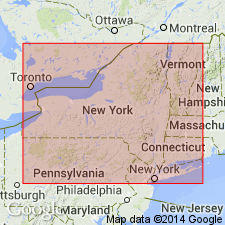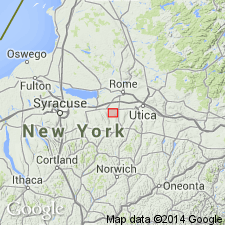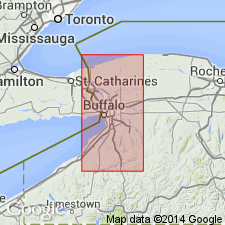
- Usage in publication:
-
- Vernon shale member
- Modifications:
-
- Named
- Dominant lithology:
-
- Shale
- AAPG geologic province:
-
- Appalachian basin
Summary:
Named Vernon shale member of Salina formation. Consists of red and green shales, gray gypsiferous shales, and thin platten dolomites. Underlies Syracuse salt and overlies Pittsford shale. [Later reports give thicknesses of 150 feet (at type locality) to 700 feet (in central NY).] Age is Silurian.
Type locality in Vernon, NY.
Source: Modified from GNU records (USGS DDS-6; Reston GNULEX).

- Usage in publication:
-
- Vernon shale
- Modifications:
-
- Reference
- Overview
- Revised
- AAPG geologic province:
-
- Appalachian basin
Summary:
Reference section designated for the Vernon shale of the Salina group along Downing Brook, which enters Oneida Creek from the east, 1.3 mi south of part of Sherrill known as Kenwood and 0.6 mi north of southern boundary of Oneida Co. Author states that the Vernon has been variously treated as a distinct formation or as a member of the Salina formation and commonly is considered to be 150 ft thick in the type area. At least five distinct rock types are represented in strata classed as Vernon, but they are so interrelated that further differentiation into smaller units is not warranted from a cartographic standpoint. The Vernon is here regarded as a phase of sedimentation (magnafacies) capable of geologic mapping; hence, it can properly be termed a formation. Name "Pittsford shale" is suppressed and the discontinuous occurrence of greenish-black shale above Lockport dolomite is included in Vernon formation. Thickness at reference section is 270 ft, however, contact with underlying Lockport is not exposed, and section does not extend up to contact with overlying Camillus. Total estimated thickness of Vernon in type area is 400 ft. Within NY, the Vernon is considered a correlative of High Falls shale of Orange and Ulster Cos. Age is Late Silurian.
Source: GNU records (USGS DDS-6; Reston GNULEX).

- Usage in publication:
-
- Vernon Formation
- Modifications:
-
- Revised
- AAPG geologic province:
-
- Appalachian basin
Summary:
Vernon Formation of Salina Group contains at least four eurypterid-bearing black shale horizons in western NY here described as lowermost(?) Harris Hill Bed (new name) at East Penfield, and Monroeav (new name), Pittsford (revised), and Barge Canal (new name) Beds at Pittsford, NY. Beds vary in thickness from approximately 1 ft for the Harris Hill to 7 ft for the Monroeav Bed. A thin dolomitic interval in the type area of the Vernon Formation in central NY containing eurypterids and fish remains is here named the Downing Brook Bed.
Source: GNU records (USGS DDS-6; Reston GNULEX).
For more information, please contact Nancy Stamm, Geologic Names Committee Secretary.
Asterisk (*) indicates published by U.S. Geological Survey authors.
"No current usage" (†) implies that a name has been abandoned or has fallen into disuse. Former usage and, if known, replacement name given in parentheses ( ).
Slash (/) indicates name conflicts with nomenclatural guidelines (CSN, 1933; ACSN, 1961, 1970; NACSN, 1983, 2005, 2021). May be explained within brackets ([ ]).

